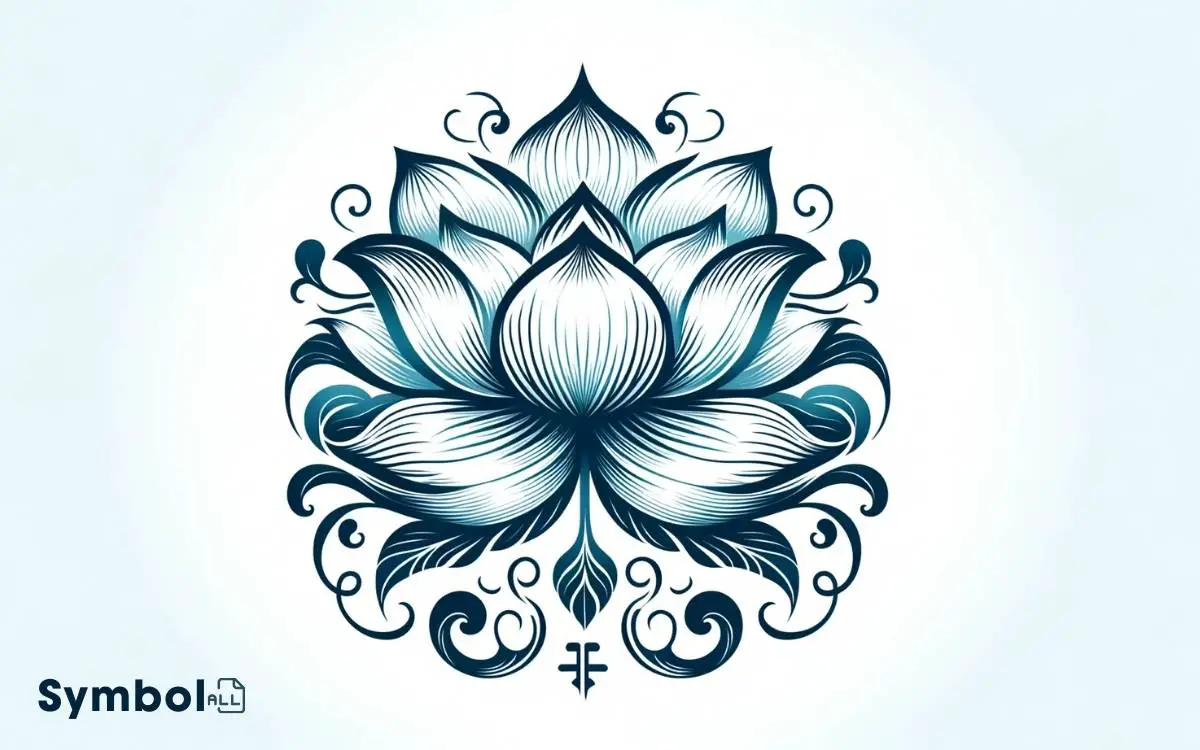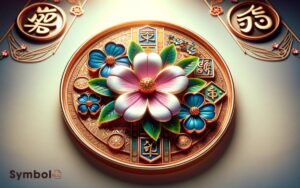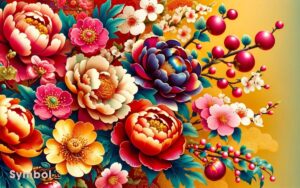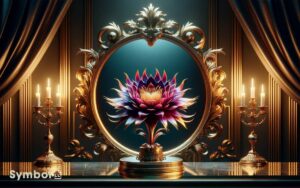Chinese Symbol for Lotus Flower: Purity, Enlightenment!
In Chinese culture, the lotus flower, 莲花 (liánhuā), is a fascinating emblem of purity, enlightenment, and the ability to rise above adversity.
This symbolism has its roots in ancient philosophies, art, and spirituality, illustrating how beauty and purity emerge from murky waters.
As a central motif in Buddhism, it represents the soul’s journey from ignorance to enlightenment, embodying purification and the triumph over obstacles.Taoist interpretations align with this, viewing the lotus as a symbol of harmony and spiritual awakening amidst chaos.
In Chinese art, the lotus’s resilience and rebirth inspire myriad representations, each carrying profound cultural undertones. Unraveling these layers offers deeper insight into its enduring significance.

Key Takeaways
Origins of the Symbol
Exploring the roots of the Chinese symbol for the lotus flower, it’s important to grasp that this symbol has been intricately woven into Chinese culture and spirituality for centuries.
Its origins are deeply embedded in ancient Chinese philosophy and art, reflecting purity and enlightenment amid adversity.
This emblem isn’t merely decorative; it embodies profound philosophical concepts, including the emergence of beauty and purity from murky waters, symbolizing the potential for spiritual elevation and moral integrity despite challenging circumstances.
Ancient texts and artworks reveal the lotus’s significance, highlighting its role in rituals and its symbolic representation of the harmonious balance between beauty and resilience.
Understanding this symbol’s deep-rooted significance offers insight into the values and aspirations that have shaped Chinese cultural and spiritual identity over millennia.
Symbolism in Buddhism
In Buddhism, the lotus flower transcends mere botanical significance, embodying the intricate processes of purification and the journey towards enlightenment.
You observe its roots in muddy water, symbolizing initial ignorance, yet its immaculate bloom represents the attainment of a pure, enlightened state.
This duality positions the lotus as both a purification symbol and an emblem of the path to enlightenment, encapsulating core Buddhist tenets.
Buddhist Purification Symbol
The lotus flower, revered in Buddhism for its purification symbolism, embodies the profound transformation from ignorance to enlightenment.
This emblematic bloom, rising unblemished from murky waters, symbolizes the purity of mind and spirit achieved through Buddhist practices.
Its significance extends beyond mere physical purity, delving into the depths of mental and spiritual cleansing. In your journey through the complex landscape of Buddhist teachings, you’ll discover the lotus as a powerful metaphor for the purification of the soul.
Its growth, from mud to magnificent flower, mirrors the Buddhist path of overcoming defilements and suffering. This symbolism isn’t merely decorative but serves as a constant reminder of the potential for purity and enlightenment inherent in all beings, regardless of their current state.
Enlightenment Path Emblem
As you explore further into Buddhism, you’ll encounter various symbols that articulate the intricate journey towards enlightenment, each carrying profound philosophical meanings and teachings.
Among these, the lotus flower stands as a quintessential emblem of the enlightenment path. Its growth, from murky waters to a pristine bloom above the surface, mirrors the human progression from ignorance to the awakening of spiritual consciousness.
This symbol underscores a fundamental Buddhist principle: purity can emerge from impurity, wisdom from ignorance.
Analyzing this emblem, you’re invited to reflect on the concept of Samsara the cycle of birth, death, and rebirth—and Nirvana, the ultimate state of liberation and enlightenment.
The lotus, accordingly, isn’t merely a botanical entity but a map guiding aspirants through their spiritual voyage, embodying the potential for transformation and transcendence inherent in all beings.
Taoist Interpretations
Considering Taoist philosophy, the lotus flower symbolizes purity and spiritual awakening amidst the chaos of the material world.
This emblematic notion stems from the lotus’s growth pattern, emerging unblemished from murky waters, an allegory for the Taoist pursuit of harmony and enlightenment.
Given such circumstances, the lotus’s journey from the mud to the surface mirrors the individual’s path through spiritual cultivation, transcending the turbidities of mundane existence.
Taoists interpret this process as an allegory for inner alchemy, where one transforms base human instincts into virtuous qualities, akin to the lotus’s ascent.
Hence, the lotus epitomizes the Taoist ideal of achieving purity and enlightenment by maneuvering through life’s complexities with grace and equanimity, embodying the principle of wu wei, or effortless action, in the pursuit of spiritual balance.
Influence in Chinese Art
You must consider how the lotus flower’s symbolic meanings have deeply influenced Chinese art, manifesting in various artistic representations.
This emblem of purity and enlightenment hasn’t only adorned scrolls and ceramics but also inspired architectural designs, reflecting its pervasive role in cultural expressions.
Analyzing these representations allows you to grasp the profound impact of the lotus motif within the broader context of Chinese artistic traditions.
Symbolic Meanings
The Chinese symbol for the lotus flower holds profound symbolic meanings, greatly influencing various aspects of Chinese art through its representation of purity, enlightenment, and rebirth.
Emerging unscathed from murky waters, the lotus epitomizes the possibility of purity from impurity, a metaphor for the human condition endeavoring towards enlightenment despite worldly temptations.
This symbolism doesn’t merely adorn the art; it imbues it with layers of meaning, engaging the viewer in a deeper contemplation of life’s cyclical nature and the perpetual quest for spiritual awakening.
The lotus’s resilience, blooming resplendently amidst adversity, serves as a powerful emblem of rebirth, insinuating that purity and enlightenment are attainable despite the surrounding chaos, a concept deeply rooted in Chinese philosophical and spiritual thought.
Artistic Representations
Imbued with deep symbolic significance, the lotus flower has profoundly influenced Chinese art, weaving its themes of purity, enlightenment, and rebirth into the very fabric of artistic expression.
You’ll find its imprints across various mediums, each portrayal rich with cultural undertones and philosophical depth.
| Medium | Description | Symbolism |
|---|---|---|
| Painting | Delicate brush strokes depict lotuses in bloom. | Transience of beauty |
| Sculpture | Stone and jade carvings of lotuses. | Eternal purity |
| Ceramics | Porcelain vases adorned with lotus motifs. | Renewal and perfection |
These artistic manifestations not only celebrate the aesthetic beauty of the lotus but also serve as a conduit for conveying deeper messages of spiritual awakening and the inherent purity of the human soul, illustrating the lotus’s enduring legacy in Chinese culture.
The Lotus in Literature
Throughout literary history, the lotus flower has symbolized purity and enlightenment, often serving as a powerful metaphor in various cultural narratives.
In Chinese literature, the lotus transcends mere floral representation; it embodies spiritual awakening and the triumph of purity over adversity.
This symbolism is intricately woven into the fabric of classical poetry and prose, where the lotus often emerges as a beacon of resilience amidst murky waters, reflecting the human condition’s inherent quest for clarity and transcendence.
Scholars have extensively analyzed its prominence in works such as the ‘Lotus Sutra,’ where its metaphorical usage underscores themes of rebirth and spiritual elevation.
Through these literary lenses, the lotus isn’t just a flower but a profound emblem of the enduring human spirit, journeying through life’s complexities towards enlightenment.
Architectural Inspirations
You’ve observed the lotus flower’s prominence in literature, but its influence extends far beyond, shaping the contours of modern and traditional architecture.
Lotus-inspired building designs not only mirror the flower’s aesthetic appeal but also imbue structures with rich symbolic meanings, reflecting purity, enlightenment, and rebirth.
Architectural elements draw from the lotus’s form and essence, creating spaces that resonate with cultural depth and innovative design.
Lotus-Inspired Building Designs
Architects around the globe have drawn inspiration from the lotus flower, incorporating its symbolic purity and beauty into innovative building designs.
This trend transcends mere aesthetic appeal, delving into the philosophical and cultural significance of the lotus, which embodies notions of rebirth and purity in various Eastern traditions.
The architectural manifestations of this inspiration are varied but share common thematic underpinnings.
- Bioclimatic Design Principles: Many lotus-inspired structures utilize natural cooling and heating, mimicking the flower’s adaptability to its environment.
- Structural Innovations: The unique geometry of the lotus has led to the development of buildings with radical structural systems, offering both strength and elegance.
- Sustainable Materials: Emulating the lotus’s connection to water and earth, architects often employ sustainable materials, reinforcing the bond between nature and human habitation.
Architectural Elements and Symbolism
Building on the innovative use of lotus symbolism in architecture, it’s important to explore how specific architectural elements and their symbolic meanings further enrich our understanding of these structures.
You’ll find that the incorporation of the lotus motif isn’t just aesthetic but deeply symbolic, reflecting purity, enlightenment, and rebirth.
Columns that mimic the lotus stem, for instance, don’t just support the structure physically; they signify the connection between the earthly and the divine, grounding the building while aspiring towards the heavens.
Similarly, the use of lotus petal shapes in doorways and windows invites a sense of entering or gazing into a sacred, pure space, transforming mundane architectural features into conduits of spiritual and philosophical significance.
These elements, when decoded, reveal a layered narrative of cultural identity, spiritual aspiration, and aesthetic intention.
Lotus in Chinese Poetry
Throughout Chinese poetry, the lotus flower emerges as a recurrent and potent symbol, embodying purity, enlightenment, and rebirth amidst adversity.
This emblematic flower represents an ideal of untainted beauty and moral integrity, often depicted as blooming unstained from murky waters. Its presence in poetry isn’t merely decorative but serves as a metaphor for the resilient and virtuous spirit of humanity.
- Metaphorical Depth: Poets utilize the lotus to signify spiritual awakening and the triumph of purity over corruption.
- Symbolic Association: The lotus is frequently associated with famous poets and sages, enhancing its cultural significance.
- Imagery and Themes: Its portrayal in poetry ranges from delicate imagery to profound themes of life, struggle, and transcendence, inviting readers to contemplate deeper philosophical and existential questions.
Philosophical Meanings
Delving into the philosophical meanings, the lotus flower embodies concepts of purity and enlightenment that resonate deeply within Chinese culture, reflecting an individual’s journey towards spiritual awakening.
This symbolism is multifaceted, encapsulating notions of rebirth, resilience, and the inherent beauty of one’s true nature amidst worldly suffering.
| Concept | Philosophical Significance | Cultural Impact |
|---|---|---|
| Purity | Emerges unscathed from mud | Virtue and integrity |
| Enlightenment | Symbolizes spiritual awakening | Path to wisdom |
| Rebirth | Continuous cycle of life | Renewal and hope |
| Resilience | Thrives in adverse conditions | Strength and determination |
Through this lens, you grasp the lotus’s profound symbolism, a affirmation to the enduring human spirit and the pursuit of purity and enlightenment in the face of life’s challenges.
Varieties and Symbolic Differences
Having explored the philosophical significances, we now turn our attention to the varieties of the lotus flower and their symbolic differences within Chinese culture.
The lotus, revered for its ability to bloom from murky waters, symbolizes purity and enlightenment across various hues, each carrying its unique connotation.
- White Lotus: Emblematic of purity and spiritual perfection, the white lotus is often associated with Bodhisattvas.
- Red Lotus: Signifying love, compassion, and other heart-centered qualities, the red lotus is closely linked to the qualities of the heart.
- Blue Lotus: Representing wisdom and knowledge, the blue lotus is symbolic of the victory of the spirit over the senses.
This differentiation in color and symbolism emphasizes the lotus’s all-encompassing representation of human experiences and spiritual journeys within Chinese cultural narratives.
The Lotus in Festivals
In Chinese festivals, the lotus flower transcends its natural beauty, embodying profound cultural and spiritual symbolism that permeates various celebratory practices.
This emblem of purity, enlightenment, and rebirth features prominently in the Dragon Boat Festival and the Mid-Autumn Festival, among others.
During these occasions, the lotus isn’t merely a decorative element; it’s a profound symbol woven into the fabric of rituals and traditions.
The flower’s integration into festival cuisine, particularly in the form of lotus seed paste used in mooncakes, signifies wishes for peace and prosperity.
Additionally, the lotus’s presence in water-based celebrations echoes the Daoist principles of harmony and balance, illustrating a deep-rooted connection between cultural festivities and the natural world.
This intricate relationship highlights the lotus’s enduring significance in Chinese cultural expressions and communal identity.
Modern Cultural Impact
You observe that the modern cultural impact of the Chinese symbol for the lotus flower manifests in various domains, particularly in:
- Artistic representations,
- Spiritual significance, and
- Fashion influences.
This symbol’s adaptation across these fields underscores its enduring appeal and versatility, reflecting broader cultural shifts towards appreciating traditional motifs in contemporary contexts.
Analyzing these areas reveals the lotus’s multifaceted role in shaping and being shaped by modern cultural expressions in China and beyond.
Artistic Representations
The symbolism of the lotus flower permeates modern artistic expressions, reflecting a nuanced understanding of its cultural significance and aesthetic appeal. Artists across mediums gravitate towards the lotus, employing its imagery to explore themes of purity, resilience, and rebirth.
This fascination isn’t merely aesthetic; it’s deeply rooted in the lotus’s rich symbolic tradition within Chinese culture. The flower’s representation in contemporary art forms underscores its enduring legacy and versatility as a symbol.
- Visual Arts: Paintings and sculptures often depict the lotus in stages of bloom, symbolizing the human journey of growth and enlightenment.
- Fashion Design: Apparel and accessories adorned with lotus motifs marry traditional symbolism with contemporary style, reflecting cultural pride and personal identity.
- Digital Media: In films and digital art, the lotus often serves as a metaphor for characters’ transformation, illustrating the interplay between tradition and modernity.
Spiritual Significance
Delving into its spiritual significance, the lotus flower transcends mere aesthetic appreciation, embodying profound themes of purity, enlightenment, and the cyclical nature of life within modern cultural contexts.
This emblematic blossom, rooted in muddy waters yet emerging unstained, serves as a metaphor for the human condition, symbolizing the pursuit of clarity and morality amidst the turbidities of existence.
In contemporary spirituality, the lotus’s narrative isn’t static; it evolves, influencing and reflecting current societal values concerning personal growth and self-realization.
Its representation in literature, mindfulness practices, and art underscores an enduring appeal, striking a chord with individuals seeking solace and meaning in an increasingly complex world.
The lotus’s spiritual essence continues to resonate, offering timeless lessons on resilience and the potential for transformation.
Fashion Influences
Amid the evolving cultural landscape, the lotus flower’s symbolism has seamlessly woven itself into the fabric of modern fashion, influencing trends and inspiring designers to incorporate its motifs into their collections.
This emblem of purity, enlightenment, and rebirth transcends mere aesthetics, embedding deep cultural narratives into contemporary wearables.
As you explore further, you’ll find:
- Textile Patterns: The lotus motif is prevalent in silk prints and embroidery, symbolizing luxury and elegance.
- Accessories: Jewelry and accessory lines draw heavily on the lotus for its spiritual symbolism, offering wearers a sense of peace and purity.
- High Fashion: Runway designs frequently feature the lotus, merging ancient symbolism with avant-garde styles, bridging cultural heritage with modern fashion narratives.
In essence, the lotus flower’s symbolic roots enrich modern fashion, blending tradition with contemporary designs for profound cultural expression.
Environmental Significance
Understanding the environmental significance of the lotus flower reveals its critical role in maintaining aquatic ecosystems‘ biodiversity and health. Thriving in waterlogged environments, the lotus not only beautifies its habitat but also serves as a cornerstone for aquatic life.
Its extensive root system aids in water purification, removing pollutants and contributing to clearer, healthier water bodies. This process supports a diverse range of aquatic organisms, fostering a balanced ecosystem.
Additionally, the lotus leaves’ unique ability to repel water and dirt, thanks to their microscopically bumpy surface, minimizes water evaporation and maintains water quality.
Consequently, the lotus’s presence indicates a robust, thriving aquatic environment, underscoring its indispensable role in sustaining biodiversity and the overall health of water ecosystems.
The Lotus in Fashion
While the lotus greatly influences aquatic ecosystems, its symbolic beauty has also permeated the world of fashion, where designers draw inspiration from its form and meaning to create innovative designs.
The lotus, embodying purity, rebirth, and enlightenment, offers a rich palette for fashion narratives, transcending mere aesthetic appeal to weave stories of resilience and beauty emerging from adversity.
- Material Innovation: Designers are exploring eco-friendly textiles mimicking the lotus’s water-repellent surface, promoting sustainability.
- Motif and Embellishment: Lotus motifs adorn garments, symbolizing purity and adding depth to the narrative of collections.
- Color Symbolism: The varied hues of the lotus inspire color palettes that evoke specific moods and themes, from serene whites to vibrant pinks, reflecting the flower’s diverse symbolism.
In this context, fashion becomes a canvas for expressing complex cultural and existential themes, with the lotus serving as a potent symbol of human aspiration and transformation.
Spiritual Practices and the Lotus
The lotus flower‘s significance extends deeply into spiritual practices, where it symbolizes enlightenment and the journey of the soul toward purity. The lotus rises untouched from muddy waters, representing the ability to overcome challenges and remain pure amidst adversity. In Hindu lotus flower symbolism, it is often associated with deities like Lakshmi and Brahma, signifying prosperity, creation, and divine beauty. Its unfolding petals are seen as a metaphor for spiritual awakening and the gradual revelation of higher truths.
You’ll find its imagery pervasive within meditative and religious contexts, signifying a transcendent, pure state achieved despite the murkiness of its origins.
This paradoxical nature mirrors the human condition, where spiritual purity is sought amidst the complexities and challenges of earthly existence.
Analyzing this symbolism, you recognize the lotus as more than a simple floral motif; it embodies the profound philosophical concept of rising above the mud of materialism and ignorance.
Its seamless integration in spiritual rituals and iconography isn’t merely decorative but serves to remind practitioners of their inner potential for enlightenment, urging a deeper engagement with their spiritual journey.
Conclusion
In sum, the lotus flower, etched deeply in the annals of time, transcends mere botanical significance to embody a rich tapestry of cultural, spiritual, and environmental symbolism.
Your journey through its origins, from ancient scrolls to modern skyscrapers, reveals a profound narrative. This emblem, steeped in Buddhist and Taoist wisdom, mirrors the human condition—blooming amidst adversity.
Its pervasive influence across art, literature, and fashion underscores its timeless relevance, offering a lens through which to view the evolving interplay between nature and culture.






